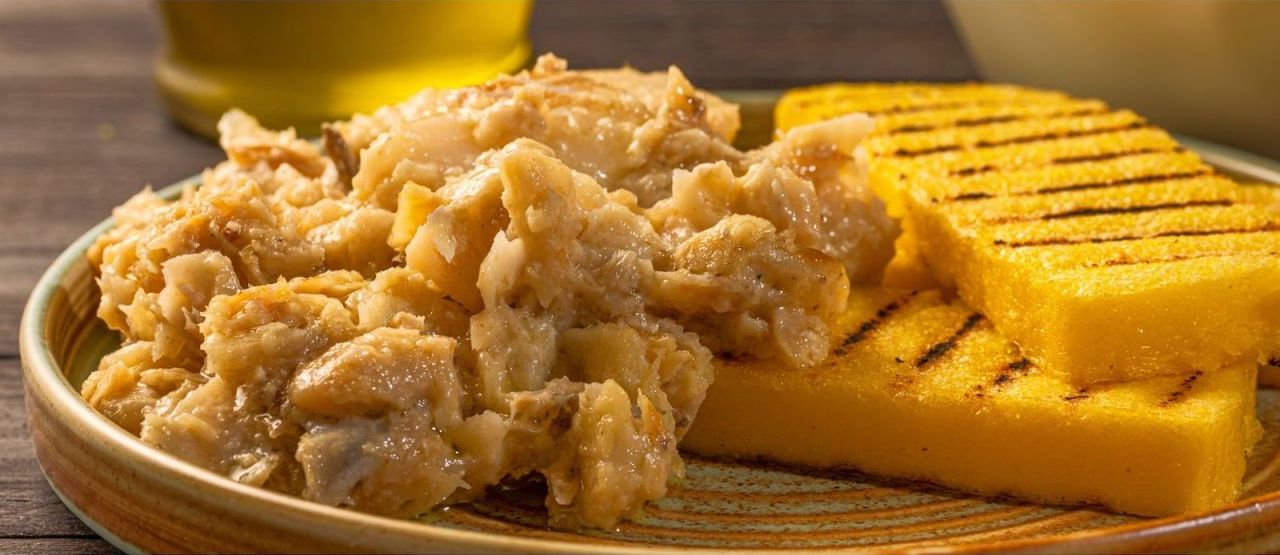An easy recipe made with simple ingredients, which however needs a patient and precise preparation. Baccalà alla Vicentina has its roots in the medieval history of Veneto, in particular the city of Vicenza; even if its origins are still uncertain, and may refer on one hand to the tradition of Venetian explorers, on the other to some kind of "diplomatic" strategy of the Vicentine army.
What is certain is that, thanks to its clean yet at the same time deep and complex flavors, this dish represents an important gastronomic excellence, not only at a regional level, but also throughout Italy and the world. So let’s discover together its secrets: the history, ingredients and the correct preparation to cook the best Baccalà alla Vicentina.

How to prepare Baccalà alla Vicentina: when was the recipe born?

The recipe for Baccalà alla Vicentina hasn’t a precise date of birth, although there are several folkloristic legends about it.
One of them tells about Pietro Querini, a Venetian sailor who in 1432 was shipwrecked near the Lofoten Islands, an archipelago located in the northern region of Norway. In this remote area so far from home, Querini and his crew noticed that the local population used to put codfish (stockfish) out to dry.
Impressed by this particular product, the sailors brought it back home, where over the following centuries it spread considerably, so much to become part of the local tradition, also for religious reasons of which we’ll talk shortly.
It should also be noted that Baccalà alla Vicentina provides for the use of stockfish, in fact, and not the real baccalà (the word ‘baccalà’ defines a different method of conservation of codfish). But, probably also for lexical reasons, the term baccalà has entered the common language, thus giving its name to the recipe we know today.
There’s another legend according to which the origins of the recipe would predate Querini’s trip to Norway. It seems that in the 13th century, during the siege of the castle of Montebello in a battle against the army of Verona, the army of Vicenza used Polenta e Baccalà as a "diplomatic weapon", to entice the Veronese to open the door of the castle and eat the delicious meal. A strategy that, apparently, proved effective and was crowned with success!
Discover the history of Venice with the Venice PassBaccalà or stockfish? Discover the difference!

As we’ve already mentioned before, the recipe of Baccalà alla Vicentina does not requires the use of the actual baccalà, but of the stockfish.
But what is the real difference between the two products?
The raw material is the same, namely codfish. What is different is the method of conservation that is used: in particular, the baccalà is preserved in salt, and in fact, in order to be actually considered a true baccalà, the codfish must have absorbed a salt content of more than 18% during the salting process.
The stockfish, on the other hand, is dried, taking advantage of specific climatic conditions occurring between February and June in Norway (which is indeed the only producer of stockfish in the world), allowing the product to air-dry outdoors for a period of about 3 months.
In addition to Baccalà alla Vicentina, stockfish is also used in other typical Italian regional recipes, such as Stoccafisso alla Ligure or Stoccafisso in Cassuola of the Neapolitan tradition.
Explore the cuisine of Veneto by trying street food in VeniceIngredients and procedure to cook Baccalà alla Vicentina

Here are the ingredients to prepare a perfect Baccalà alla Vicentina (portions for about 6 people):
- Stockfish, 1kg;
- Onions, 250-300g;
- Salted sardines, 3 or 4;
- Grana Padano grated, 20g;
- Flour, 75g
- Extra Virgin Olive Oil;
- Milk, 180ml;
- Parsley;
- Salt;
- Pepe.
To make this traditional dish of Vicenza, the stockfish must be well pounded, and above all, soaked in cold water for about 3 days and then dried for at least one night, after which it has to be cut into square pieces.
Next, we slice and sauté the onion with the addition of a glass of oil. Rinse the sardines to desalt them and put them in the pan, stirring and cooking them over low heat until they dissolve into a sort of cream (about 50-60 minutes). At the end, off the heat, we add the chopped parsley.
At this point, we procede to fill the pieces of stockfish with a part of the prepared mixture, then flour them and put them in a pan (possibly earthenware or aluminum), covering them with the remaining onion and sardines mixture and adding the Grana cheese, milk, salt and pepper.
Now we just have to pipare, as it's traditionally said in Vicenza; which means, we must cook over gentle heat for about 4 or 5 hours, keeping in mind that there is not an exact cooking time of the stockfish, as it depends on the type. The important thing is that, in the end, the product is soft (but not falling apart), white and with an intense aroma.
All that’s left is to serve it hot and accompanied by slices of polenta, to get a tasty and typical recipe of the classic Venetian cuisine.
Baccalà alla Vicentina, festivals and tradition
In the period between September and October, throughout the area surrounding the beautiful city of Vicenza, there are several festivals dedicated to the recipe of Baccalà alla Vicentina.
An example is the festival "Poènta e Bacalà" which takes place in the village of Thiene, in a picturesque atmosphere that celebrates the tradition not only of this delicious dish, but also of many other typical products of the area, including polenta itself, risotto or the traditional dessert known as Treccia di Thiene (Thiene’s braid).
The presence of this kind of parties and events related to Baccalà alla Vicentina gives a good idea of how this dish represents an important and identifying symbol for the whole area. This representation of identity becomes even more evident if we analyze the way in which the recipe has gradually spread more and more over the centuries.
In fact, beyond the extraordinary goodness of flavors and although using ingredients such as codfish coming from Northern European countries, Baccalà alla Vicentina has become a very appreciated food because it’s really eclectic and perfectly matched to the religious needs of Catholic countries.
Imported stockfish was perfect to be eaten instead of meat on days when it was customary to eat lean, such as Fridays during Lent, Holy Friday and Christmas Eve. It was also a much cheaper food than fresh fish, and also easy to store.
This explains the cultural reasons for the success of Baccalà alla Vicentina, both in the province of Vicenza and in the whole Veneto territory; a product whose ancient traditions are now safeguarded by the Confraternita del Bacalà alla Vicentina, an association founded in 1987 to protect and promote the original and authentic version of the recipe.
About the author
Written on 13/02/2024




Alessandro Savino
A delicious and typical dish of the gastronomic tradition of Veneto: let’s find out curiosities and secrets on how to cook Baccalà alla Vicentina.